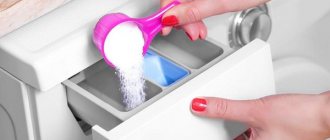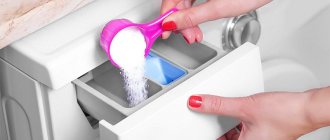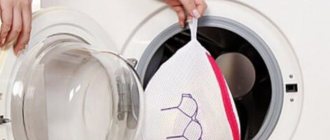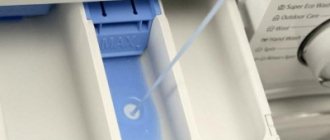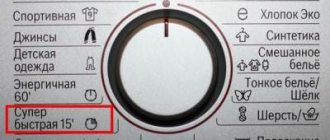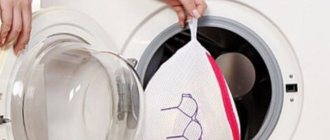Compartments in a washing machine: their purpose, differences and designations. What product and where should I put it in the washing machine? Is it possible to pour powder directly into the drum of a washing machine?
An automatic washing machine is perhaps the most useful invention according to women all over the planet. This device saves a lot of time and effort. In addition, it protects the delicate skin of women’s hands and also protects it from the harmful effects of water and chemicals. It would seem that there is nothing easier than throwing laundry into the machine and starting it up.
But it's not that simple. Many housewives quite often have difficulties with intricate compartments for detergents. Despite the fact that there are only three of them (and sometimes 2), women are afraid of harming their new assistant and do not risk using them to the fullest. This article will try to correct the current situation and help our lovely ladies in solving their problems.
How many compartments and what are they for?
In common models of machines with both top and side loading, the manufacturer provides a special compartment for adding washing components.
In side-loading washing machines, it is located at the top of the front panel, next to the appliance control panel. In top-loading equipment, in order to see the powder compartment, you need to open the hatch cover. The compartment can be located next to the drum or directly on the lid.
Opening the powder tray, you can see 3 compartments into which it is divided.
The purpose of each of these compartments is determined by the icon depicted on it:
- The Latin letter A or Roman numeral I indicates the prewash compartment. Powder is poured into it if the appropriate program is selected, where the washing procedure consists of 2 stages. From this compartment the powder will be washed into the drum during the first stage.
- Latin letter B or Roman numeral II - this is how the compartment for the main wash is designated, regardless of the program, as well as the second stage of washing in a mode with a preliminary stage.
- The star or flower icon indicates the conditioner or rinse aid compartment. The product intended for this separation is usually in liquid form. You can pour conditioner into this compartment both before and during washing. The main thing is to be in time before the machine starts to draw water for rinsing. Otherwise, the product will not penetrate into the drum.
Also, in the compartments numbered I or II, in addition to the main laundry detergent, you can add bulk stain removers, bleaches and products for cleaning the machine from scale and dirt.
The third compartment can only be used for components used in rinsing laundry.
Combined cleaning
Is water not getting into the compartment? The cuvette is completely clogged. Cleaning with chemicals will not work. Mixed cleaning will help. It goes like this:
- Pull out the device and soak it in a basin in water for 5 minutes (water temperature - at least 60 degrees).
- Add or pour chemical into the water and mix well.
- Let the dispenser sit in the solution for several hours.
- Remove the container and scrub vigorously with a brush.
- Rinse, dry and reinstall.
How to download correctly
Washing machines from different manufacturers have significant differences in the range of programs and washing modes. The amount of powder that will be consumed during a particular washing program is indicated in the operating instructions for the household appliance. In addition, each manufacturer of synthetic detergent for automatic cars indicates its approximate dosage on the packaging. But all this data is conditional.
The following factors may influence the dosage of washing powder:
- Initial weight of loaded laundry. The greater the weight, the more product you need to add. If only a few items are to be washed, the calculated amount of product should be reduced.
- Degree of pollution . If things are heavily soiled or have stains that are difficult to remove, the concentration of the powder should be increased.
- Water hardness level . The higher it is, the more detergent will be needed for a positive washing result.
- Washing program. Different types of fabrics require different amounts of detergent.
Load powder, stain remover or bleach strictly into the appropriate tray before starting the washing process.
In order to pour the powder, it is best to use a special measuring cup.
It has a convenient spout that allows you to pour powder exactly into the compartment, and there are marks on its walls, making it easy to measure the required amount of powder. You can buy it at any hardware store. Also, some manufacturers of washing powders put it in the package with the product as a nice bonus. This usually applies to packages with a large weight.
There is an opinion that the powder can be poured directly into the drum after loading laundry there. This method has both positive and negative sides.
pros
less detergent consumption;
possibility of washing if the cuvette breaks;
Possibility of washing when the hoses supplying water for washing off the powder are clogged.
Minuses
less detergent consumption;
possibility of washing if the cuvette breaks;
Possibility of washing when the hoses supplying water for washing off the powder are clogged.
If there is a need to add the product directly to the drum, you need to use special plastic containers for this.
Their use will protect the laundry from bleaching, and small holes in the lid of such a container will allow the powder to dissolve inside and the soap solution to be poured into the drum gradually.
Detergent in the form of gels and capsules can be loaded directly into the drum of the washing machine. Most often, they do not have aggressive components, and their application to clothing will not damage it.
In some models of washing machines, manufacturers have provided a dispenser for gel-based laundry care products.
It is a plate that must be installed in the main powder compartment, where special grooves are located. Then pour in the gel. There will be a small space between this partition and the bottom of the compartment, through which the gel will enter the drum only when the water supply starts.
The easiest way to figure it out is by adding conditioner. You can pour it both before washing and during the washing process, before rinsing. The amount of rinse aid required is indicated on its packaging. But even if the conditioner is used less or more than the specified norm, this will not affect the cleanliness of the laundry.
How to clean powder from a washing machine: chemicals to help
We figured out how to wash powder in a tray with light dirt. It may happen that mechanical cleaning was unsuccessful. Contaminants in the form of old detergent, plaque, and mucus remain in the compartment.
What to do in this case? How to dissolve hardened laundry detergent and stubborn dirt? There is only one way out - use the right chemistry. With its help, you can tidy up the dispenser, as well as the insides of the washing machine. Great, because other parts also need cleaning.
Follow the instructions:
- Open the detergent compartment and add the amount of chemical recommended by the manufacturer. Do not exceed the norm so that the parts do not break.
- Remove things from the drum and turn the SMA to “idle” at a maximum temperature of 90–95 degrees.
- Restart the rinse cycle.
Cleaning the tray and machine is finished!
This method has its drawbacks. The main one is that it does not allow you to remove old dirt and completely clean a very dirty compartment.
Options for placing trays in different types/brands of machine
- LG. The machines from this company have a classic 3-section tray division. The right compartment is for pre-wash, the left for the main wash. The manufacturer identifies the conditioner container in blue.
- Bosh. Top-loading machines have the following arrangement of receivers: on the left is a compartment for pre-wash, in the middle for rinse aid, on the right for the main wash.
- Samsung. Washing machines are equipped with a 3-section tray. The left compartment is for the main wash, the right is for the additional wash. The air conditioning section is painted blue.
- Indesit. The leftmost section is for additional washing, the middle one for the main wash. The compartment with the flower serves as a rinse aid receptacle.
Is it possible to pour powder into a drum?
Any modern washing machine has a tray for detergents. It is this compartment, according to the manufacturer’s plan, that should ensure the flow of powder into the drum with dirty laundry. But sometimes it can be poured directly into the machine.
This exception is suitable for powders that are very foamy. Basically, these are soap-based products with poor solubility in cold water, and the manufacturer necessarily warns about this feature of the product on the packaging.
Among the powders that can be poured into the drum are for washing children's clothes. They have a special gentle formula and are not washed off so well with water from the receiving tray. Proponents of pouring powder directly into the drum claim that this improves the quality of washing and saves detergents.
Opponents are inclined to think that the powder in this mode comes into contact with the laundry undiluted and can spoil the products. Manufacturers of washing machines do not give clear prohibitions on pouring powder directly into the drum. Unlike using bleaches and stain removers in this way, they can only be loaded into the receiving tray.
Where to pour shampoo and liquid washing powders
Most often, “shampoos” are called means for cleaning high-tech or down clothes, which have their own subtleties in care. For proper use, always follow the instructions of the manufacturer of the shampoo itself and the washing machine itself.
Do not use shampoos to wash your hair in automatic machines. They are ineffective for most types of dirt, lather too much and can damage your machine!
What is special about liquid products? Once in the tray, they literally immediately (without the participation of water) begin to flow into the drum. Some machine manufacturers provide an additional curtain in the tray. It serves for accurate calculation of liquids (as it has divisions), but in general it also does not prevent drainage.
In machines with a different tray structure, this curtain may not be present. Then users are advised to pour liquid detergent into the main wash compartment immediately before starting or use special containers that are placed in the drum along with dirty clothes.
Sometimes manufacturers prohibit pouring liquid products directly into the tray, so always read the instructions carefully!
Where to put capsules and tablets for washing
Capsules and tablets further simplify the washing process, since there is no need to fuss about the dosage of powder - these products are designed for 4-5 kg of laundry. In case of heavy soiling and a larger volume of items, 2 capsules or tablets can be used per wash cycle.
Before starting the machine and loading laundry, the capsule must be placed on the bottom of the drum. This will ensure its uniform and rapid dissolution. Pour conditioner into the tray of the machine and you can start the cycle. The gel contained inside the capsule will quickly react with water and begin to clean the products literally from the first minutes of washing.
Tablets are used in 2 ways: placed in a powder container (i.e., in a tray) or, like capsules, directly in a drum. There is no fundamental difference in the use of methods, but faster (and therefore more effective) dissolution of tablets occurs in the drum.
The fastest way to clean the tray
If the contamination is not too strong, a quick rinse of the tray under hot water will help. Stages of the procedure:
- take out the container;
- remove all removable elements of the powder receiver;
- rinse all parts under running hot water; if stains are not washed off, remove them with a sponge;
- wipe the inside of the machine where the reservoir was located with a damp cloth;
- connect all structural elements and insert the tray into place.
How to download correctly
Washing machines from different manufacturers have significant differences in the range of programs and washing modes. The amount of powder that will be consumed during a particular washing program is indicated in the operating instructions for the household appliance. In addition, each manufacturer of synthetic detergent for automatic cars indicates its approximate dosage on the packaging. But all this data is conditional.
The following factors may influence the dosage of washing powder:
- Initial weight of loaded laundry. The greater the weight, the more product you need to add. If only a few items are to be washed, the calculated amount of product should be reduced.
- Degree of pollution . If things are heavily soiled or have stains that are difficult to remove, the concentration of the powder should be increased.
- Water hardness level . The higher it is, the more detergent will be needed for a positive washing result.
- Washing program. Different types of fabrics require different amounts of detergent.
Load powder, stain remover or bleach strictly into the appropriate tray before starting the washing process.
In order to pour the powder, it is best to use a special measuring cup.
It has a convenient spout that allows you to pour powder exactly into the compartment, and there are marks on its walls, making it easy to measure the required amount of powder. You can buy it at any hardware store. Also, some manufacturers of washing powders put it in the package with the product as a nice bonus. This usually applies to packages with a large weight.
There is an opinion that the powder can be poured directly into the drum after loading laundry there. This method has both positive and negative sides.
pros
less detergent consumption;
possibility of washing if the cuvette breaks;
Possibility of washing when the hoses supplying water for washing off the powder are clogged.
Minuses
the likelihood of bleaching and stains on colored clothing as a result of granules;
poor washing quality due to uneven distribution of powder among items;
incomplete dissolution of the powder during washing.
If there is a need to add the product directly to the drum, you need to use special plastic containers for this.
Their use will protect the laundry from bleaching, and small holes in the lid of such a container will allow the powder to dissolve inside and the soap solution to be poured into the drum gradually.
Detergent in the form of gels and capsules can be loaded directly into the drum of the washing machine. Most often, they do not have aggressive components, and their application to clothing will not damage it.
In some models of washing machines, manufacturers have provided a dispenser for gel-based laundry care products.
It is a plate that must be installed in the main powder compartment, where special grooves are located. Then pour in the gel. There will be a small space between this partition and the bottom of the compartment, through which the gel will enter the drum only when the water supply starts.
The easiest way to figure it out is by adding conditioner. You can pour it both before washing and during the washing process, before rinsing. The amount of rinse aid required is indicated on its packaging. But even if the conditioner is used less or more than the specified norm, this will not affect the cleanliness of the laundry.
What to clean: the best products
We have decided how to combat pollution. Now let’s find out what is the best way to wash fossilized washing powder. Use factory-made household chemicals. It will bring the cuvette and the main components of the unit into proper shape.
The most popular means:
- Frisch Activ. An effective remedy in the fight to keep the dispenser clean. Suitable for trays with light soiling.
- "Doctor TEN." Recommended for dry cleaning of the washing machine and dispenser. Also used for minor stains.
- Sandokkaebi. The most effective composition of South Korean production. It cleans not only the container, but also the hoses and pipes of the SMA. An important advantage is the affordable price.
For soaking the tray, you can use more aggressive chemicals, because it is not poured into the machine. Suitable products for cleaning plumbing fixtures and toilets. For example, “Domestos” or “Toilet duckling”.
What detergents are used for washing?
The market of synthetic products for automatic units is constantly updated with new products. Each consumer can easily choose the right product for him. When choosing, it is important to consider the composition, price, and country of production.
But there are a number of important components that you should consider before purchasing a synthetic detergent.
- In machines, you must use only the product that is intended for machines of this type. The required mark is on each package. Such products contain components that reduce foaming, which helps the powder to rinse out of the fabric fibers faster. The composition also contains substances that soften water, which helps protect equipment parts from scale and increase the service life of the unit.
- To wash children's clothes you need to choose a separate type of detergent . This powder contains hypoallergenic components. Children's underwear must be washed separately from the rest.
- It is advisable to wash colored items with powder, the packaging of which is marked “Color” . It contains no bleaches, and also contains color-preserving components.
- When choosing a detergent for washing woolen and knitted items, preference should be given to shampoo-type options. They contain components that will help maintain the original shape of the product.
- When purchasing fabric conditioner or fabric softener, you need to pay attention to its consistency. It is better to choose a thicker composition, since the liquid one will be quickly used up. It won’t hurt to decide on the aroma of the conditioner - if the smell is strong, then it will not disappear from the clothes for a long time after washing.
Personal experience
I myself received a washing machine in a very unsightly state. I cleaned the tray with different means, and this is what I got.
There was everything in the tray: plaque, mold, powder
First, I tried using Cif cream with microgranules and a whitening effect. I successfully use the cream in the kitchen. The advantage of this product is its creamy consistency. It is convenient to apply, it does not spread or leak out of the tray. And it also has a pleasant smell. I left the product on for 15-20 minutes and then scrubbed it off with a brush. Of course, there was an effect, but it was insignificant. Most likely, this cream will cope with fresh stains. It will not help in advanced cases.
Next, I tried a product from Faberlic for ovens and stoves based on caustic soda. Its consistency is also an advantage. The product is available in the form of a thick, colorless gel. The smell is unpleasant, but weak - tolerable. After 15 minutes of soaking there was a slight improvement. This means that it still works a little better than Cif cream.
This is what the tray looked like after treatment with household chemicals
Then I turned to folk remedies. The first thing I used was baking soda. Using a toothbrush, I wiped all the surfaces with soda slurry. The downside is that in order for the soda to “work”, you had to rub as hard as you could.
Tray after treatment with soda
Finally, I soaked my tray in a 9% vinegar solution overnight. Soaking is inconvenient - the tray is large. I had to adapt it in such a way that the vinegar would not spill out of the pockets. The next morning, the limescale deposits had not disappeared, but the tray had noticeably turned white.
The vinegar didn’t cope with the stain, but it significantly refreshed the tray.
From my experiment we can draw an unambiguous conclusion: all remedies are good if used on time.
Caring for the tray: how to pull it out and clean it
The tray in the washing machine is a kind of receiving and dispensing point. Despite the fact that it comes into direct contact with detergents, it must be additionally washed and dried. This will protect it from plaque, mold and will guarantee full operation of the machine.
In models with vertical loading, cleaning containers for powder and conditioner is quite difficult, since manipulations must be carried out stationary. Front-loading machines do not have this problem - the tray can be pulled out.
For this purpose, modern models have a special button (indicated by the inscription PUSH). In some machines, this is a special plastic lever located directly in the air conditioning compartment. If there are no such devices, the tray can be pulled out by simply pulling it towards you.
Professionals recommend cleaning the tray after every 2-3 washes. In this mode there will be no need for additional manipulations. The tray can be cleaned with a simple sponge or brush. If this fails, try using agents to combat plaque and mold.
Another option is cleansing using improvised means: soda, vinegar and citric acid. Select effective laundry detergents, load them according to all standards, and be sure to clean the tray. Then your assistant will delight you with clean and fresh linen for a long time!
Use of capsules
Special washing capsules are designed for direct loading into the drum. Under the durable shell of the product there is a concentrated gel. During washing, the capsule gradually dissolves. The gel is evenly mixed with the total volume of water, without eating away stains on clothes.
Liquid products can be poured into the tank provided they do not contain aggressive concentrated additives. This includes various rinses, conditioners, and fabric softeners. You need to know where and when to apply any powder or solution. This is the only way to guarantee high-quality and safe washing.
